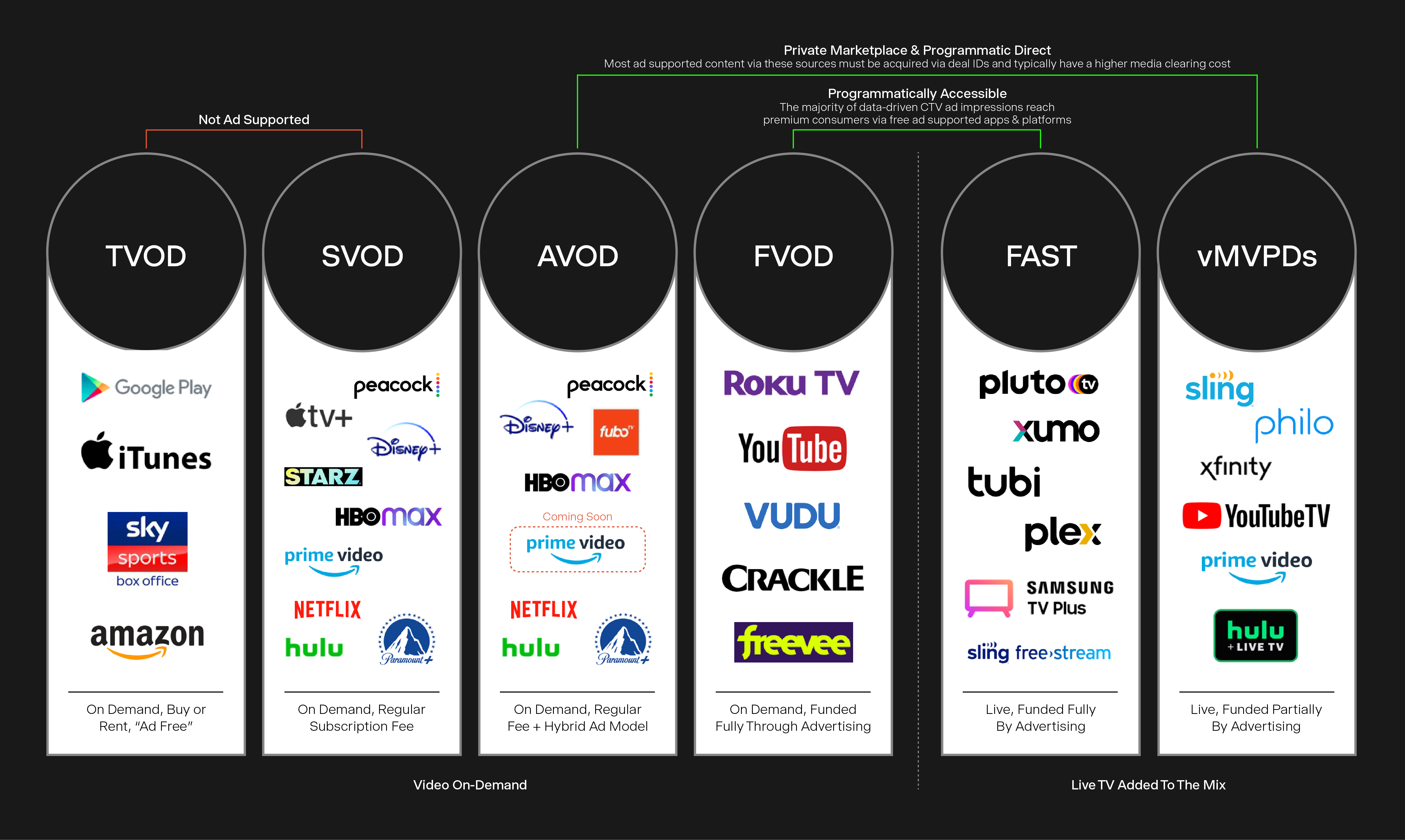Advertising in a Connected Age: Making Sense of Today’s Streaming TV Landscape
In advertising, the consumer sets the rules. And one of the rules that is quickly becoming an absolute is how they consume TV content. Connected TV (CTV) has been growing steadily, and in August 2022, it overtook cable TV. Today, there are over 15 billion connected devices across the globe, enabling consumers to choose what, when, and on which device(s) they want to view TV content.
Both the popularity of streaming TV and the proliferation of connected devices have led to significant market fragmentation. This, in turn, makes it difficult for advertisers to navigate the space.
Today, there are six categories of streaming TV, which are either ad-free or ad-supported. This blog post will help advertisers navigate the streaming TV landscape.
AD-FREE TV
There are two types of ad-free streaming:
- TVOD, or transactional video on demand, is a media distribution model in which viewers pay for individual video content on a pay-per-view basis. For example, a viewer may opt to rent a movie on Amazon Prime.
- SVOD, or subscription video on demand, is a model in which viewers pay a monthly or annual fee for access to a library of shows and movies. Another example: Amazon Prime! Is it any wonder advertisers are confused by the CTV landscape?
AD-SUPPORTED TV
There are four types of streaming TV that allow advertisers to reach and engage audiences. They are:
- AVOD, or advertising video on demand. This is a media distribution model where viewers can access video content for free, or for a lesser fee, but the content is interspersed with advertisements. AVOD consumption accelerated considerably after the COVID-19 pandemic, when consumers began first canceling and then cycling paid subscriptions. AVOD allows them to continue to subscribe to a streaming service, but rather than pay, they agree to watch ads.
- FVOD, or Free Video on Demand, is a media distribution model where viewers can access video content for free, without a subscription or payment. Roku TV and YouTube are examples of FVOD.
- FAST is Free Ad-Supported Television, a type of streaming service that offers free access to live and linear TV channels, like traditional TV, but with advertisements interspersed throughout the content. Examples for FAST include:
- Pluto TV, owned by Paramount
- Tubi, owned by Fox
- Freevee, owned by Amazon
- Zumo, owned by Comcast
It’s easy to confuse FAST with AVOD, but here’s the main difference: FAST offers free access to live and linear TV channels, while AVOD offers free or lowered access to on-demand video content.
- vMVPD, or virtual Multichannel Video Programming Distributor, is a streaming service that provides multiple television channels over the internet without supplying its own data transport infrastructure. Sling, Xfinity, and YouTube TV are all examples. vMVPD is similar to cable TV in terms of the consumer’s access to multiple channels, but it comes at a lower price point.
REACHING CONSUMERS ACROSS CTV
Given the migration to streaming TV, CTV ad spending is projected to reach $21.5 billion by 2025. The vast majority of streamed TV inventory is sold programmatically. There are multiple flavors of programmatic CTV, including:
- Private Marketplace – an auction with a limited audience of advertisers selected by the CTV publisher or provider.
- Programmatic Direct – a type of programmatic advertising that involves a direct deal between a publisher and an advertiser.
- Programmatic Accessible – auctions that allow multiple publishers to sell inventory to multiple advertisers.
This graphic illustrates auction types supported by the four types of CTV:

HOW ADVERTISERS TARGET CTV INVENTORY
There are two primary ways to target within CTV: audience and inventory.
With audience-focused targeting, advertisers can reach specific audiences based on user-specific data, demographics, psychographics, and location-based information. Simpli.fi offers multiple options for audience-focused targeting:
- Household Addressable Targeting: Our Addressable Targeting Solution offers household addressable targeting using both first-party data and custom audiences based on more than 3,000 data variables.
- Location-Based Targeting: ZTV is our ZIP code optimized advertising solution. It bridges the gap between traditional linear TV and CTV, providing highly targeted and cost-effective advertising options for advertisers. Our proprietary ZIP Ranker identifies the most relevant ZIP codes of the 41,000+ in the U.S. for a given campaign, allowing advertisers to target their CTV ads with precision and efficiency.
- Intent-Based Targeting: Leverage our intent-based targeting options to reach users based on their online behavior, interests, and intent.
Some marketers may prefer to target by inventory, which Simpli.fi supports, enabling advertisers to reach their audiences on premium content. With this approach, advertisers focus on the content that attracts their relevant audience and meets their campaign goals (i.e. price, performance, etc.). Features include:
- High-Quality Inventory. Simpli.fi’s ZTV solution delivers granular audience targeting on high-quality inventory, which is a perfect solution for advertisers with high brand-suitability standards.
- Curated Marketplaces. This summer, we partnered with Audigent to create a curated marketplace featuring more than 500 PMP deals (in addition to the thousands in our Deal Library), enabling advertisers to access premium inventory to reach consumers via streaming TV.
The future of streaming TV advertising relies on robust advertising platforms and their solutions, such as ZTV, that allow advertisers to target with an audience-first and inventory-first perspective at a reasonable price.
Ready to leverage streaming TV to build your customer base?
Fill out the form below, contact your Simpli.fi representative, or email us at hi@simpli.fi for the next steps.
Relevant Posts For You